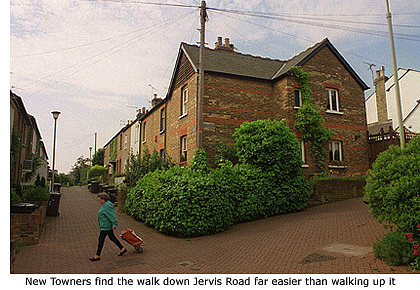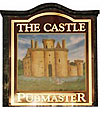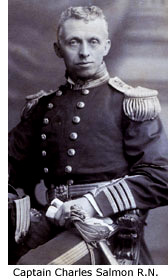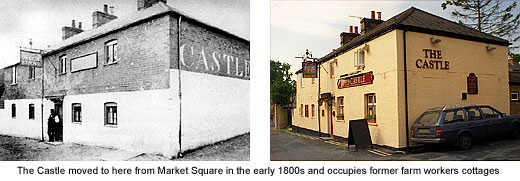|
Chapel Row, the narrow thoroughfare alongside the former Baptist church, takes its name from a small Victorian Chapel school built here in 1876 to act as a baptists’ Sunday school. After it moved in 1928 to new premises in Portland Road, the old school house became a meeting place for Bishop’s Stortford’s Jehovah’s Witnesses.
 This religious society first emerged in the 1870s as a Bible study group in Allegheny, Pennsylvania, founded by Charles Taze Russell. Within a few years, dozens of congregations had spread to neighbouring states and in 1884 his group merged with a similar religious society to form the Watch Tower Bible Tract Society. By 1909 it had become an international concern and in an effort to convert people to their religion in this country, members soon began travelling out from their London headquarters on day trips to rural areas. This religious society first emerged in the 1870s as a Bible study group in Allegheny, Pennsylvania, founded by Charles Taze Russell. Within a few years, dozens of congregations had spread to neighbouring states and in 1884 his group merged with a similar religious society to form the Watch Tower Bible Tract Society. By 1909 it had become an international concern and in an effort to convert people to their religion in this country, members soon began travelling out from their London headquarters on day trips to rural areas.
They first arrived in Bishop’s Stortford around 1915, but with so many religious groups already established in the town their task wasn’t an easy one. Then, in 1931, to distinguish themselves from other denominations of Christendom worldwide they renamed themselves Jehovah’s Witnesses – the name based on Isaiah 43:10–12.
Locally, the change of name made little difference and even after the Second World War membership here remained in single figures. But dogged persistence was eventually rewarded, and by the early 1950s a small congregation began holding regular meetings in various hired rooms around the town. As their number increased, the need for a permanent base became paramount and in 1954 they purchased the old Victorian Chapel school.
It remained their home until 1975 when the council deemed it necessary the building should be demolished. Undeterred, a new building named Kingdom Hall was erected on the same site within four months, financed and mostly built by the Witnesses themselves. Its contemporary design in brick and glass certainly doesn’t warrant any architectural merit but every admiration is due to them for creating their own meeting house.
Much of this area is due for redevelopment in the not too distant future and it seems likely the Jehovah's Witnesses will have to find new premises.
|
|
When New Town was first developed, three roads running parallel from east to west were named Front Row, Middle Row and Back Row. The former is now called Newtown Road but most of the Victorian terraces that stood in the latter two roads have since been replaced by new developments. Middle Row does still exists in name only, and Back Row was later redesignated Oak Street after the Royal Oak public house which stood opposite its western entrance in Apton Road.
Up until the early 1960s Oak Street was also home to the Sawyer’s Arms public house, the inspiration for its distinctive title presumably coming from the first recorded landlord John Tyler, a wood sawyer. Fordham’s brewery acquired the pub in 1854 and it was last owned by Flowers brewery.
Other thoroughfares created here when New Town was built were Jervis Road, Bartholomew Road, Sidney Terrace, Castle Street, Portland Road and Trinity Street, the latter since extended to form part of the original Back Row. Most of the houses on the north side of Newtown Road stem from the 1890s, but a few small cottages erected before the arrival of the railway in 1842 can still be found on the south side. A plaque on the wall between Nos 31 and 33 declares: ‘Cottages built by the Benefit Society held at the Castle 1828’ – the Castle referred to being the public house at the end of Castle Street.
 The original Castle was an alehouse in Market Square (See Guide 2), the inspiration for its name no doubt coming from its high position overlooking the site of ancient Waytemore Castle. But, for reasons unknown, it moved in the early 1800s to New Town and started life again in this row of former farm workers’ cottages. Castle Street took its name from the pub. Between 1867 and 1909 the Castle’s landlord was William Salmon, at that time the oldest licence holder in Bishop’s Stortford. He died aged 94.
The original Castle was an alehouse in Market Square (See Guide 2), the inspiration for its name no doubt coming from its high position overlooking the site of ancient Waytemore Castle. But, for reasons unknown, it moved in the early 1800s to New Town and started life again in this row of former farm workers’ cottages. Castle Street took its name from the pub. Between 1867 and 1909 the Castle’s landlord was William Salmon, at that time the oldest licence holder in Bishop’s Stortford. He died aged 94.
When and where William Salmon was born is unknown but on 1 February 1841 his marriage produced a boy named Charles, said to have been born at the former *Red Lion Inn in one of the rooms that projects above the pavement of Hockerill Street.(See Guide 9 - Red Lion Inn)
Charles Salmon was schooled in Stortford and in May 1853, aged 12, was articled to JE McConnell, inventor of the 'Bloomer' locomotive engine, at the Wolverton Works of the North Western Railway. Seven years later he honed his engineering skills working at the Royal Arsenal, Woolwich, and at the age of 20 entered the Royal Navy as 2nd Assistant Engineer.
 There followed a long and distinguished naval career in which he held many important engineering posts at home and abroad including Fleet Engineer and, from c1887–1893, Engineer-in-Chief of the royal yacht Alberta. This regularly carried Queen Victoria and other members of the royal family across the Solent to her Isle of Wight residence, Osbourne House. The Queen was always gracious to Captain Salmon and he was often invited to royal functions at Osbourne. He was also held in high regard by the Prince of Wales, later King Edward VII. There followed a long and distinguished naval career in which he held many important engineering posts at home and abroad including Fleet Engineer and, from c1887–1893, Engineer-in-Chief of the royal yacht Alberta. This regularly carried Queen Victoria and other members of the royal family across the Solent to her Isle of Wight residence, Osbourne House. The Queen was always gracious to Captain Salmon and he was often invited to royal functions at Osbourne. He was also held in high regard by the Prince of Wales, later King Edward VII.
In the course of his naval service he became known by most officers in the Fleet and was a trusted advisor and personal friend of most Admirals of his time. He retired with the rank of Chief Inspector of Machinery, which now is the equivilant of Engineer-Admiral.
In civilian life Charles lived at Erith in Kent. He became superintendent and, later, director of Vickers armaments and ammunition factory in Erith, leaving in 1909, and for six years was a member of Erith Urban District Council. He was also a JP. Charles Salmon died in January 1931, three weeks short of his 90th birthday. Such was his standing and popularity in Erith that Salmon Road, Bexley, was named in his memory.
Photograph and information about Charles Salmon is courtesy of Ian Salmon.
*1841 was also the year in which Henry Gilbey took over the Red Lion after his coaching service went out of business. Whether or not William Salmon was the landlord he took over from isn't known.
|
|
From 1874 to the late 1930s Castle Street was also home to a small dairy owned by the Thickings family. In winter time they kept their cows in nearby cattle sheds, which were also used for milking, but in summer *George Thickings and his brother would twice daily drive the herd through the town’s streets to graze on the Meads and at Hockerill (See Guide 10 - Stansted Road).
*George Thickings: born c 1840, died 10 September 1926, aged 86
Jervis Road is the continuation of New Path (See Guide 14), the steep climb eventually leading to Sidney Terrace, Apton Road and New Cemetery. The building of Sidney Terrace at the turn of the 20th century was by local builder Frederick Cannon, financed by the building and sale of Highland House in Dunmow Road. A shrewd man, Mr Cannon insisted these properties only be rented to railway workers as they were regularly employed and it would ensure prompt and regular payment of rent. Sidney Terrace is said to have been named after the first baby born here – needless to say the son of a railway worker.
|





 This religious society first emerged in the 1870s as a Bible study group in Allegheny, Pennsylvania, founded by Charles Taze Russell. Within a few years, dozens of congregations had spread to neighbouring states and in 1884 his group merged with a similar religious society to form the Watch Tower Bible Tract Society. By 1909 it had become an international concern and in an effort to convert people to their religion in this country, members soon began travelling out from their London headquarters on day trips to rural areas.
This religious society first emerged in the 1870s as a Bible study group in Allegheny, Pennsylvania, founded by Charles Taze Russell. Within a few years, dozens of congregations had spread to neighbouring states and in 1884 his group merged with a similar religious society to form the Watch Tower Bible Tract Society. By 1909 it had become an international concern and in an effort to convert people to their religion in this country, members soon began travelling out from their London headquarters on day trips to rural areas. The original Castle was an alehouse in Market Square (See Guide 2), the inspiration for its name no doubt coming from its high position overlooking the site of ancient Waytemore Castle. But, for reasons unknown, it moved in the early 1800s to New Town and started life again in this row of former farm workers’ cottages. Castle Street took its name from the pub. Between 1867 and 1909 the Castle’s landlord was William Salmon, at that time the oldest licence holder in Bishop’s Stortford. He died aged 94.
The original Castle was an alehouse in Market Square (See Guide 2), the inspiration for its name no doubt coming from its high position overlooking the site of ancient Waytemore Castle. But, for reasons unknown, it moved in the early 1800s to New Town and started life again in this row of former farm workers’ cottages. Castle Street took its name from the pub. Between 1867 and 1909 the Castle’s landlord was William Salmon, at that time the oldest licence holder in Bishop’s Stortford. He died aged 94.